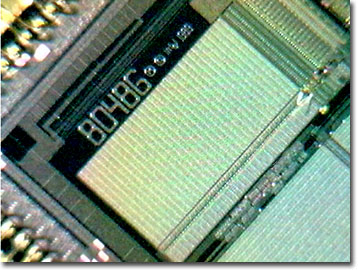Integrated Circuit Image Gallery
Intel 486DX Microprocessor
In 1989, the 32-bit 486DX heralded Intel's fourth generation of microprocessors with two radical innovations: the integration of the floating-point unit (FPU) on the same chip and the addition of an internal write-through 8-Kbyte memory cache. With 1.2 million transistors on an 81-square millimeter silicon substrate, the chip was photolithographed with 1.0-micron complementary metal oxide semiconductor (CMOS) technology and was a tremendous advance over the reigning 80386 central processing unit (CPU).

View a second image of the Intel 486DX.
View a third image of the Intel 486DX.
The 486DX processor initially had a clock speed of 25 MHz using a 5-volt power supply with a maximum power dissipation of 5 watts. Increasing the millions of instructions performed per second (MIPS) from 20 to 27, the 1990 release ran at a clock speed of 33 MHz, followed by the 50 MHz clock speed version of the 486DX capable of 41 MIPS. All three models of the Intel 486DX supported 4 gigabytes of addressable random access memory (RAM) and featured 32-bit internal register and external bus widths.
The DX designation was given to the original 486 CPU after the stripped-down SX version was released in 1991, and is used in embedded models still in production. This move echoes Intel's renaming of the 386 to the 386DX as the economical and less powerful 386SX was released. Clock-doubling and quadrupling versions added performance by increasing the internal clock speeds of the 486s. There are embedded and low-power versions also, making the family much larger than that of the previous 386s.
Contributing Authors
Omar Alvarado, Thomas J. Fellers and Michael W. Davidson - National High Magnetic Field Laboratory, 1800 East Paul Dirac Dr., The Florida State University, Tallahassee, Florida, 32310.
BACK TO THE INTEGRATED CIRCUIT IMAGE GALLERY
BACK TO THE DIGITAL IMAGE GALLERIES
Questions or comments? Send us an email.
© 1995-2025 by Michael W. Davidson and The Florida State University. All Rights Reserved. No images, graphics, software, scripts, or applets may be reproduced or used in any manner without permission from the copyright holders. Use of this website means you agree to all of the Legal Terms and Conditions set forth by the owners.
This website is maintained by our
Graphics & Web Programming Team
in collaboration with Optical Microscopy at the
National High Magnetic Field Laboratory.
Last Modification Friday, Nov 13, 2015 at 01:19 PM
Access Count Since September 17, 2002: 8889
Visit the website of our partner in introductory microscopy education:
|
|
